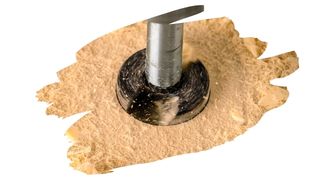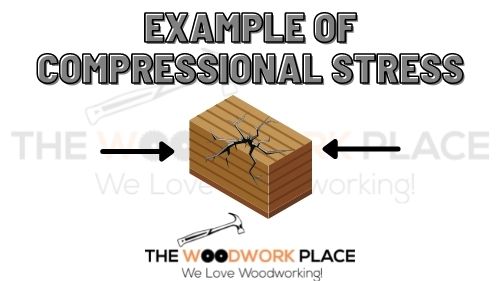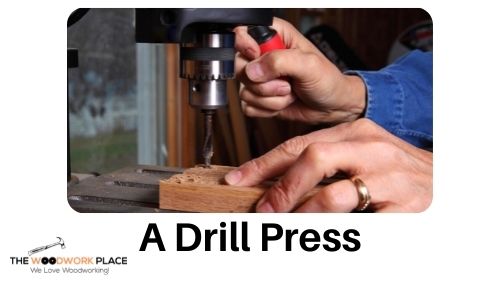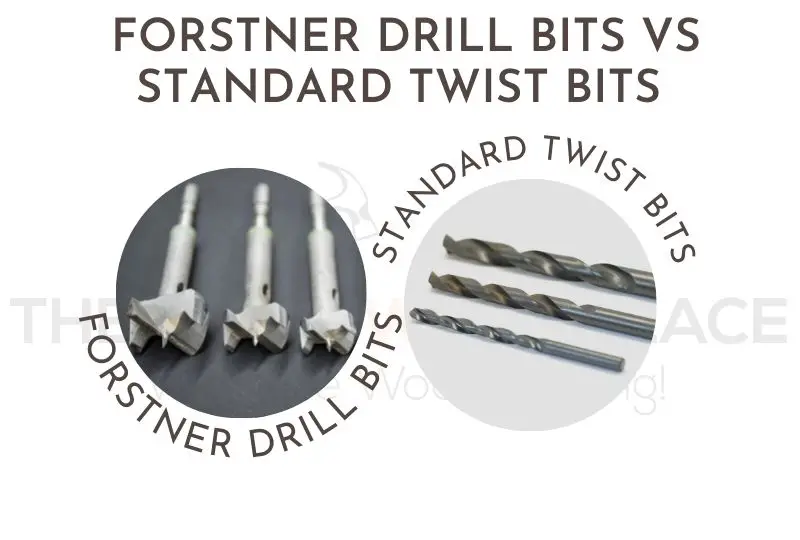Drilling into Balsa wood can be more than a little tricky…don’t let anyone try to convince you otherwise.
You can run into a lot of problems trying to drill through Balsa with a hand drill…whether it be manual or otherwise. And there’s a good reason for this.
Balsa wood is a great wood to whittle and carve, mostly due to it’s low density. However, that low density work’s against you when it comes to drilling this lightweight lumber.
So, when you need to drill through Balsa wood, what can you do?
Well, in this post, you’ll learn why Balsa wood is more difficult to drill than any other type of hardwood. You’ll also find out the exact type of power tool you should be using to drill Balsa with (spoiler alert: it’s not a hand drill!).
And, we reveal the specialized drill bit that’s ideal for cutting pin-point holes into Balsa wood.

This post may contain affiliate links to products that we receive a commission for (at no additional cost to you). Learn more here.
The Trouble With Drilling Balsa Wood
Balsa wood is an incredibly lightweight hardwood. And that is because this timber doesn’t have much density to it at all. It is filled with voids, making it more air than wood fiber underneath the surface.
In fact, according to the Janka Hardness Scale, (which measures how much force it takes to dent a piece of wood), Balsa wood has a Janka rating of just 70lbf.
Which means it takes a mere 70lbs of force to break through this hardwood.
Compare that to say another hardwood such as Maple wood. Maple wood has a Janka rating of 1450lbs, making Maple wood up to 20 times harder than Balsa!
So, because it takes so little force to snap Balsa in two, you end up running into a bunch of problems when you take a drill to it…
1) Manual Drills Put Too Much Pressure On Balsa Wood
Even drilling Balsa wood with a standard manual hand drill is difficult. Especially as just a bit too much pressure, can end up splitting Balsa apart.
2) Standard Drills Can Blow Out The Pilot Hole
Even predrilling a pilot hole does little to prevent tearing from happening around the pilot hole itself.
3) Balsa Wood Isn’t Very Dense For A Hardwood
As one of the softest lumbers on the market, you can’t go treating Balsa like any other hardwood. And that includes taking a standard drill to it.
Related Post: What Is The Best Type Of Glue For Balsa Wood Models?
Isn’t Balsa Wood Supposed To Be Strong? Just How Strong Is Balsa Wood?
Don’t be misled by Balsa Woods very low Janka rating. Balsa wood actually has an incredibly good weight to strength ratio.
You see, the Janka rating is just one way to assess wood strength. That Janka rating measures how much force it takes for a small metal ball to dent a piece of wood. So, the Janka measurement reflects woods ‘Compressional Strength’.
Compressional strength tracks how well wood can hold up before it collapses in on itself due to compressional stress.

Balsa wood, however, has great shear strength. Shear strength measures how well wood can hold up when under shear stress.

However, when it comes to drilling Balsa wood, we’re focused on Balsa woods compressional strength (what little of it there is).
So, Does This Mean You Can’t Drill Balsa Wood?
You can drill Balsa wood, just not with a hand drill. The only way to cleanly drill through Balsa wood is to use a drill press with a Forstner bit.

Also referred to as a Drilling Machine, a drill press will keep a drill fixed, so that you can make very precise holes in Balsa.
It also allows you to drill slowly, whilst applying a very low amount of top-down pressure. This is key if you want to prevent Balsa wood from cracking as you drill.
But a drilling machine is only half the solution. In addition to using a drill press, you need to use a Forstner drill bit if you want to keep those hole edges clean.
What Are Forstner Drill Bits?
The shape of Forstner drill bits are wildly different from the standard twist bits.

While twist bits are formed into a long spiral twist, Forstner bits have a flat saw-toothed end. And that saw-tooth metal will drill a clean-cut hole into even the most soft timber surfaces.
And Why Would You Use A Forstner Drill Bit?
Due to the fact that Forstner bits are both flatter and wider, you minimize the chance of Balsa wood splintering and blowing out around this specialized bit.
Plus, these bits are designed for drilling into tricky surfaces, just like Balsa. So combine a drill press with Forstner bits, and you’ll be able to drill clean holes into any piece of Balsa timber.
To Sum Up, Here Are The 3 Key Takeaways From This Post…
- 1). Balsa Wood is too soft to manually drill by hand. You need to be very exact about the amount of pressure you put on this low density wood.
- 2). If you want to drill through Balsa wood, you should to use a Drill Press. This will allow you to minimize the amount of force you put onto Balsa wood as you drill.
- 3). Also, use a Forstner bit. This special drill bit will cut a more precise hole than a twist bit, and will minimize the chance of Balsa wood blowing out and tearing.
Reference:
Da Silva, Andre, and Stelios Kyriakides. “Compressive response and failure of balsa wood.” International Journal of Solids and Structures 44.25-26 (2007): 8685-8717.
